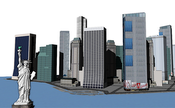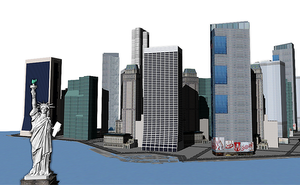Information
- Publication Type: Master Thesis
- Workgroup(s)/Project(s):
- Date: July 2010
- Date (Start): 4. March 2008
- Date (End): 21. July 2010
- TU Wien Library:
- First Supervisor:
Abstract
Creating large-scale virtual environments for interactive applications such as computer games poses a demanding challenge for computer graphics. Urban environments are usually hand-crafted by artists using commercial 3D modeling software. For today’s detail-rich games, this becomes less and less feasible. Procedural modeling techniques strive to help artists to create virtual worlds in less time. In this thesis, I present a system that helps artists and game designers to plan, layout and model urban environments for games and other media. Methods are described to create street networks manually and procedurally and to edit them interactively at any time in the development process. A stable street tessellation technique is employed that is able to represent street segments as well as crossings connecting an arbitrary number of streets and that adapts to the underlying terrain. Furthermore, I propose a constraint based method to automatically populate a city with buildings from a set of existing building models.Additional Files and Images
Additional images and videos
 image:
Result from a Manhattan-like scene created with the methods described in this thesis.
image:
Result from a Manhattan-like scene created with the methods described in this thesis.
Additional files
Weblinks
No further information available.BibTeX
@mastersthesis{scharl-master-thesis,
title = "Artist-Controlled Modeling of Urban Environments",
author = "Johannes Scharl",
year = "2010",
abstract = "Creating large-scale virtual environments for interactive
applications such as computer games poses a demanding
challenge for computer graphics. Urban environments are
usually hand-crafted by artists using commercial 3D modeling
software. For today’s detail-rich games, this becomes less
and less feasible. Procedural modeling techniques strive to
help artists to create virtual worlds in less time. In this
thesis, I present a system that helps artists and game
designers to plan, layout and model urban environments for
games and other media. Methods are described to create
street networks manually and procedurally and to edit them
interactively at any time in the development process. A
stable street tessellation technique is employed that is
able to represent street segments as well as crossings
connecting an arbitrary number of streets and that adapts to
the underlying terrain. Furthermore, I propose a constraint
based method to automatically populate a city with buildings
from a set of existing building models. ",
month = jul,
address = "Favoritenstrasse 9-11/E193-02, A-1040 Vienna, Austria",
school = "Institute of Computer Graphics and Algorithms, Vienna
University of Technology ",
URL = "https://www.cg.tuwien.ac.at/research/publications/2010/scharl-master-thesis/",
}

 poster
poster thesis
thesis

